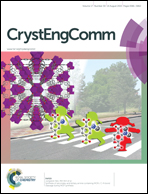Structural diversity in coordination polymers with a semirigid Lewis acidity ligand: structures and properties†
Abstract
Reaction of semirigid Lewis acidity ligand 1-carboxymethylpyridinium-4-carboxylate (L) with various salts affords five new coordination networks: two 2D layered coordination polymers [Ag2(L)(NO3)]·H2O (2) and [Pb(L)(NO3)] (3), and three 3D metal–organic frameworks [Cu4(L)4(OH)2Cl2]·11.55H2O (1), [Pb3(L)4Br2(H2O)2] (4) and [Pr(L)2(H2O)2(NO3)] (5). Complex 1 features a planar tetranuclear [Cu4(μ3-OH)2]6− cluster as a 6-connected node, connecting with eight L ligands to generate a tilted α-Po type structure. Compared with 1, 2 possesses a unique 2D double-layered structure with 1D channels, which is composed of (4,4) topological networks pillared by nitrate anions. Complexes 3 and 4 are both made up of 1D chains. 3 is composed of homo-chiral 21 helices, which provides a chiral 2D polymeric network, whereas 4 consists of two types of infinite 1D chains linked in a cross-like fashion, which displays a 3D plywood-like structure. Complex 5 consists of 4-connected metal nodes, which exhibits a 3-fold interpenetrating 3D diamondoid framework. The results suggest that the semirigid L ligand adopting different coordination modes plays important roles in determining the final structures of complexes 1–5. Moreover, complexes 3 and 5 with an acentric space group show modest powder second-harmonic-generation (SHG) efficiency at room temperature. Based on the Lewis acidity of the pyridinium unit of ligand L, complexes 1–5 were also used as catalysts for aza-Diels–Alder reaction.


 Please wait while we load your content...
Please wait while we load your content...